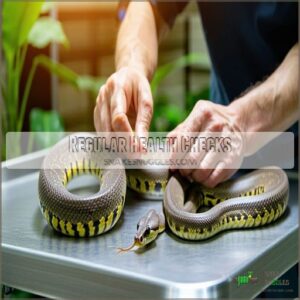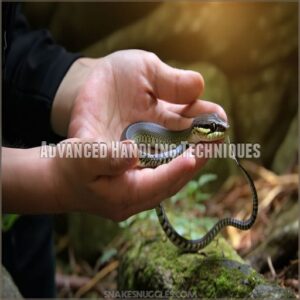This site is supported by our readers. We may earn a commission, at no cost to you, if you purchase through links.

Approach slowly from the side, using gentle movements and soft speech. Support their entire body when handling, avoiding sudden jerks that might startle them.
Create a zen habitat with consistent temperature, dim lighting, and minimal disturbances. Regular health checks and appropriate enrichment activities can substantially reduce anxiety.
Remember, each snake is unique, so patience and observation are key to understanding their individual stress triggers and comfort zones.
Table Of Contents
- Key Takeaways
- Snake Stress Reduction
- Handling Snakes Safely
- Reducing Snake Stress
- Snake Stress Management
- Advanced Handling Techniques
- Creating Stress-Free Environment
- Long-Term Stress Reduction
- Frequently Asked Questions (FAQs)
- How to reduce stress in snakes?
- What are the ways to reduce tension?
- How do you improve a snake’s battling ability?
- How do you get rid of snakes?
- How do you reduce stress on reptiles?
- How to desensitize a snake?
- What Are the Long-term Effects of Stress on a Snake?
- How Can the Environment of a Snake’s Habitat Be Changed to Reduce Stress?
- What Are the Best Ways to Handle a Snake to Prevent Stress?
- Is It Safe to House Multiple Snakes Together?
- Conclusion
Key Takeaways
- You’ll minimize your snake’s stress by recognizing early warning signs like muscle tremors, color changes, and irregular breathing, allowing you to intervene quickly before serious issues develop.
- Create a zen habitat by carefully managing temperature, providing hiding spots, and maintaining consistent environmental conditions that mimic your snake’s natural ecosystem.
- You’ll reduce handling-related stress by moving slowly, supporting the snake’s entire body, and keeping interaction times short – typically 15-30 minutes – to prevent overwhelming your serpent companion.
- Master gentle handling techniques by approaching from the side, using soft speech, and avoiding sudden movements that might trigger defensive or anxious behaviors in your snake.
Snake Stress Reduction
You’ll want to master snake stress reduction to keep your scaly friend healthy and happy.
Understanding how to recognize, prevent, and manage stress can transform your relationship with your snake, ensuring a calm and comfortable companion.
Recognizing Stress Symptoms
Recognizing snake stress symptoms is important for keeping your serpent companion healthy. Want to catch stress signals early in your slithery friend? Look out for these telltale signs:
- Sudden skin color changes
- Muscle tremors or unusual body twitching
- Heavy, irregular breathing patterns
- Dramatic appetite loss or defensive postures
These stress indicators help you quickly address your snake’s well-being before serious issues develop. Understanding a stress free habitat is key to creating an environment that reduces anxiety in snakes.
Calming Techniques
Spotting those telltale signs of stress, you’re ready to soothe your slithery friend.
Gentle touch works wonders – move slowly, speak softly, and use calming scents to create a zen atmosphere.
Minimize interaction, dim the lights, and play soft background music.
These snake calming techniques transform a stressed serpent into a relaxed companion, helping your scaly buddy feel safe and secure.
Environmental Adjustments
After mastering calming techniques, your snake’s habitat becomes the next frontier in stress reduction.
Smart habitat design means more than just a box—it’s about creating a sanctuary.
Regulate temperature and humidity like a pro, control lighting with great care, and plan your snake’s spatial environment with precision.
These environmental adjustments transform a simple enclosure into a serpent’s stress-free haven.
Handling Snakes Safely
When handling your snake, you’ll want to master the art of calm, confident interaction that keeps both you and your scaly friend feeling secure.
Learning to approach slowly, support their entire body, and avoid sudden movements will transform your snake-handling skills from nerve-wracking to smooth and stress-free.
Approaching Snakes Calmly
When approaching a snake, think of yourself as a silent predator – slow, deliberate, and calculated. Quiet movements and soft speech are your secret weapons for calm handling.
Move from the side, avoiding direct eye contact that might trigger defensive responses.
Understanding safe handling techniques is essential for reducing stress and creating a positive interaction. Your gentle touch and steady approach will help reduce snake anxiety, creating a stress-free interaction that keeps your serpent companion relaxed.
Supporting Snake Body
Now that you’ve approached your snake calmly, mastering full body support is your next move. Think of handling your snake like cradling a delicate instrument; precision matters. Using support hooks can greatly aid in this process.
Here’s how to nail secure handling:
- Spread your hands to distribute weight evenly
- Support the entire snake’s length
- Keep your grip firm but gentle
- Move slowly and confidently
Your goal? Preventing injury and reducing snake stress with every touch.
Avoiding Sudden Movements
Sudden movements can transform your snake handling from smooth sailing to a stressed-out snake rodeo. Learn to move like a slow-motion ninja, keeping your actions deliberate and predictable.
Check out this quick guide to minimize startling your scaly friend:
| Action | Impact | Recommendation |
|---|---|---|
| Rapid Movements | High Stress | Avoid Completely |
| Slow Lifting | Low Stress | Preferred Method |
| Predictable Approach | Calm Response | Always Recommended |
| Gentle Support | Snake Comfort | Essential Technique |
| Minimal Handling | Stress Reduction | Best Practice |
Smooth, calm handling is your ticket to a stress-free snake experience. Minimize startling your snake by avoiding rapid movements and prioritizing slow, predictable interactions.
Reducing Snake Stress
If you’re a snake owner, you’ve likely noticed how stress can dramatically affect your serpent’s health and behavior.
By understanding and implementing targeted stress reduction techniques, you’ll create a calm, secure environment that helps your snake thrive and guarantees a happier, healthier companion.
Providing Comfortable Environment
After mastering safe handling, creating a comfortable habitat becomes your snake’s stress-reduction lifeline.
Design an enclosure that mimics their natural environment, focusing on proper thermal gradients, humidity levels, and strategically placed hiding spaces.
Choose substrate carefully and provide enrichment activities that make your serpent feel secure and stimulated in their stress-free sanctuary.
Feeding and Hydration Tips
Your snake’s health hinges on precise feeding and hydration strategies. Consider these critical tips:
- Match prey size to snake’s body diameter
- Establish consistent feeding schedules
- Provide fresh, clean water daily
- Monitor hydration through skin elasticity and behavior
Efficient hydration systems and diverse food types prevent stress, ensuring your serpent companion remains healthy and content.
Avoiding Over-Handling
When feeding time winds down, remember snakes aren’t social butterflies.
Respect their boundaries by handling them sparingly.
Too much human interaction can spike stress levels faster than a snake’s strike.
Observe their behavior closely and limit interaction duration.
Less is more in the case of handling, which promotes gentle and infrequent touch.
Gentle, infrequent touch keeps your serpent companion calm and content.
Gentle Handling Methods
After limiting handling, mastering gentle techniques becomes your snake-care superpower. Soft snake support transforms interactions from stressful to smooth.
Here’s how to nail calm handling:
- Use a snake hook for initial contact, maintaining a respectful distance
- Support the snake’s entire body with slow, deliberate movements
- Adopt a soft grip that whispers "I’m a friend" instead of shouting "I’m a threat"
Investing in proper snake hooks is essential for safe snake handling. Gentle lifting isn’t just a technique—it’s an art form that reduces snake stress.
Minimizing Handling Time
Snake stress is a ticking time bomb of potential health issues. Minimizing handling time isn’t just a suggestion—it’s a survival strategy for your serpent companion.
Recognizing stress signs is essential to address the root causes of snake stress. Keep gentle handling sessions brief, typically 15-30 minutes, to prevent overwhelming your snake.
Short, calm interactions reduce stress, protect your snake’s mental well-being, and maintain a trusting relationship. Always read your snake’s body language to ensure gentle handling sessions are beneficial.
Snake Stress Management
You’ve got a slithery friend who needs some TLC, and managing snake stress isn’t just a skill—it’s an art form that’ll keep your serpent sidekick happy and healthy.
By understanding your snake’s unique stress signals and mastering gentle handling techniques, you’ll transform potential anxiety into a calm, trusting relationship that’ll make you the ultimate snake whisperer.
Regular Health Checks
Keeping your slithery friend healthy means staying ahead of the game with vet checkups.
Proactive health monitoring catches potential issues before they become serious.
Early detection protocols help you spot stress signs, track behavior changes, and guarantee your snake stays in top shape.
To minimize stress during these visits, consider reptile care techniques.
Regular assessments are your secret weapon in preventative care.
Nutritional Considerations
Anything can derail a snake’s well-being, but a balanced diet is your secret weapon.
Nutritional considerations are fundamental for managing stress and maintaining peak health.
Provide varied meals rich in vitamins and minerals, tailoring portions to your snake’s species and age.
Consistent meal scheduling and proper hydration levels can transform your serpent’s overall vitality and reduce stress substantially.
Enrichment Activities
Stimulation is the secret sauce for keeping your snake mentally sharp and stress-free.
Introduce puzzle feeders that challenge your snake’s problem-solving skills, like hiding prey in complex enclosure setups.
Climbing branches, textured surfaces, and rotating habitat decorations provide essential mental and physical enrichment.
These activities prevent boredom and mimic natural exploration behaviors, reducing anxiety and promoting overall well-being.
Advanced Handling Techniques
You’ve entered the domain of advanced snake handling, where precision and patience become your secret weapons in managing serpent stress.
Whether you’re confronting an aggressive snake or learning to handle venomous species, these expert techniques will transform your approach and build a bond of trust with your scaly companion.
Handling Aggressive Snakes
When dealing with an aggressive snake, approach like a chess master—strategically and cautiously.
Understanding each snake’s unique temperament helps minimize stress and reduce defensive behaviors.
Read their body language carefully, move slowly, and avoid sudden movements.
Mastering proper handling techniques is essential for building trust with your serpent companion.
Keep handling sessions brief and calm, using gentle techniques that signal safety and build trust with your serpent companion.
Specialized Venomous Snake Handling
If you’re stepping into venomous snake handling, buckle up for a serious skill set.
Expert training is your golden ticket – no shortcuts allowed.
A professional snake hook becomes your best friend, keeping a safe distance while maintaining control.
Protective gear isn’t optional; it’s your lifeline.
Specialized venom handling requires nerves of steel, precision, and respect for these potentially dangerous serpents.
Gradual Acclimation
After handling venomous snakes with caution, introducing new serpents demands a measured approach.
Your acclimation methods should prioritize slow, methodical environmental adaptation.
Start by placing the snake’s container near its new habitat, allowing gradual stress-free relocation.
Minimize direct interactions, letting the snake explore and adjust independently, with patience becoming your greatest tool in reducing snake stress and building trust.
Creating Stress-Free Environment
You’ll transform your snake’s habitat into a sanctuary by mastering key environmental design techniques that minimize stress.
Crafting the perfect enclosure isn’t just about aesthetics—it’s a science that directly impacts your serpent companion’s mental and physical well-being.
Optimal Enclosure Design
Mastering your snake’s home base starts with smart enclosure design. Think beyond just four walls – create a mini-ecosystem with strategic hide boxes and climbing structures that’ll make your serpent feel like royalty.
Understanding proper snake enclosure setup is essential for creating an environment that reduces stress, as seen in the guide on snake enclosure setup.
Smart ventilation systems, varied substrate options, and thoughtful lighting designs transform a basic tank into a snake sanctuary that reduces stress and keeps your scaly friend happy.
Maintaining Ideal Temperature
Your snake’s comfort hinges on precise temperature control methods. Just like Goldilocks, your serpent needs conditions that are just right.
Here’s how to nail thermal gradient perfection:
- Use digital thermometers to track precise heat zones
- Implement ceramic heat emitters or radiant heat panels
- Create distinct warm and cool areas in the enclosure
Temperature isn’t just a number—it’s your snake’s lifeline to stress-free living.
Minimizing External Disturbances
When temperature control sets the stage, noise reduction becomes your next strategic move.
Snakes are hypersensitive to environmental disruptions, turning your living space into a potential stress minefield.
Here’s a quick guide to minimizing external disturbances:
| Disturbance Type | Mitigation Strategy |
|---|---|
| Loud Sounds | Soundproofing, quiet zones |
| Vibrations | Anti-vibration mats, stable placement |
| Foot Traffic | Isolate enclosure, reduce movement |
| Human Activity | Calm environment, limited interactions |
Protect your serpent’s sanctuary by buffering against sensory intrusions.
Long-Term Stress Reduction
In regard to keeping your snake happy and healthy, long-term stress reduction isn’t just a goal—it’s a thorough approach that requires consistent care and keen observation.
You’ll want to implement specialized strategies that address your snake’s unique needs, monitoring their behavior and environment to create a sustainable, calm living space that supports their physical and psychological well-being.
Implementing Stress Reduction Strategies
Managing snake stress reduction requires a methodical approach.
Implement gradual strategies that map out specific stress signals and response techniques.
Track your snake’s behavior, noting patterns of anxiety and calm, break down stress reduction into measurable steps, creating personalized interventions that speak directly to your serpent’s unique temperament and environmental needs.
Addressing Species-Specific Stress
Each snake species brings unique stress triggers that demand specialized approaches. Your ball python might retreat when overstimulated, while a corn snake could become defensive.
Species research reveals how habitat design and environmental factors directly impact snake behavior. Creating a proper reptile habitat is vital for reducing stress in snakes.
Understanding these nuanced stress reduction strategies means recognizing that what calms one snake might agitate another – it’s all about species-specific needs.
Monitoring Progress and Adjusting Care
Keep an eagle eye on your snake’s stress reduction journey.
Track health markers, behavior patterns, and subtle stress signs like changes in appetite or movement.
Regularly log observations in a journal, noting shifts in your serpent’s demeanor.
Tweak your care strategy based on these insights, ensuring a personalized approach to your snake’s well-being.
Frequently Asked Questions (FAQs)
How to reduce stress in snakes?
You’ll cut snake stress by creating a calm habitat with perfect temps, minimal handling, and gentle touch.
Provide hiding spots, move slowly, and read your snake’s body language to build trust and keep them cool and comfortable.
What are the ways to reduce tension?
Did you know 85% of snake stress stems from improper handling?
Gently support their body, move slowly, and create a calm environment.
Minimize handling, provide hiding spots, and maintain consistent temperature to help your slithery friend feel secure and relaxed.
How do you improve a snake’s battling ability?
Boost your snake’s battling prowess by maintaining ideal health through balanced nutrition, consistent training, and stress management.
Create a supportive environment that mimics natural habitats, ensuring peak physical and mental conditioning for resilience.
How do you get rid of snakes?
Seems like uninvited serpents are crashing your party?
Seal entry points and remove attractants like wood piles. Use natural repellents like clove oil and install snake-proof fencing.
Call professionals for persistent or venomous snake problems.
How do you reduce stress on reptiles?
Reduce reptile stress by creating a calm, stable environment with proper temperature, humidity, and hiding spots.
Handle gently, minimize handling time, and observe their behavior to address potential stressors quickly and effectively, creating a stable environment.
How to desensitize a snake?
Imagine a snake so jumpy it could leap through the ceiling!
Start by creating a calm environment, gradually introducing gentle handling.
Use slow movements, soft touches, and frequent, short interactions to build trust and desensitize your slithery friend.
What Are the Long-term Effects of Stress on a Snake?
Chronic stress can devastate a snake’s health, triggering weakened immunity, stunted growth, and organ damage.
You’ll notice declining health, increased disease susceptibility, and potential reproductive issues if stress remains unchecked long-term.
How Can the Environment of a Snake’s Habitat Be Changed to Reduce Stress?
Hide, climb, regulate: transform your snake’s habitat by adding secure hideouts, vertical structures, and precise temperature-humidity controls.
Minimize noise, create consistent routines, and watch your serpent friend thrive in a personalized, stress-free sanctuary, with a well-designed environment that incorporates secure hideouts.
What Are the Best Ways to Handle a Snake to Prevent Stress?
When handling a snake, move slowly and deliberately.
Support its entire body, avoid sudden movements, and keep handling sessions short.
Approach from the side, speak softly, and let the snake feel secure in your gentle, confident grip.
Is It Safe to House Multiple Snakes Together?
You’ll want to avoid housing multiple snakes together, as it can lead to territorial conflicts, stress, and potential disease transmission.
Different species and individual temperaments make cohabitation risky for your slithery companions.
Conclusion
Managing, nurturing, and nourishing your snake’s well-being demands patience, understanding, and expertise.
By mastering snake stress reduction techniques, you’ll transform your serpent companion’s life from anxious to tranquil.
Remember that consistent, gentle handling, ideal environmental conditions, and keen observation are your greatest tools.
Whether you’re a novice or experienced handler, these strategies will help you create a harmonious relationship with your scaled friend, ensuring their physical and psychological health.
- https://www.merriam-webster.com/dictionary/shy
- https://snakesnuggles.com/how-to-handle-a-snake-without-stressing-it/
- https://familysnake.com/guides/soothing-your-serpent-effective-techniques-to-ease-snake-stress/
- https://www.veterinary-practice.com/article/reducing-stress-for-reptiles
- https://todaysveterinarynurse.com/behavior/low-stress-veterinary-visits-for-reptiles/

















